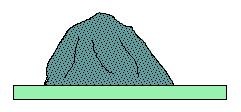1. Introduction
Obtaining thin sections (microscopic preparations)
The process is similar to the one used in petrography for rock preparations, with the difference that before starting the process, the soil sample has to be given cohesion. This is done by putting the soil sample in a recipient and it is included at vacuum in a polyester resin. When the resin is polymerised, it hardens producing a compact block that encompasses the soil sample, conserving its natural structure with no alterations. From this moment, the entire process described in petrographic manuals can be followed.
The main steps are as follows:
![]() Preparing the sample
Preparing the sample
As nearly all the commercial resins that are used for fixing the soil samples are hydrophobes, any water must be extracted first.
The most simple method is air drying, but other methods
are also used. The main ones are: freeze drying and replacing the soil's
water with other products, such as alcohol or acetone
![]() Fixing (impregnation and hardening)
Fixing (impregnation and hardening)
Several types of artificial resins are used to fix the soil samples:
- Unsaturated polyester resins, which, as they are very viscous, must be reduced by adding styrene monomer or acetone. Polymerisation is started by adding an activator and a catalyst.
- Epoxy resins. Polymerisation is obtained by the simple mixing of two components of resin.
- Methyl methacrylate. Polymerisation is started by adding a catalyst and it is usually necessary to heat.
- Other products. Such as Canadian balsam and polyethylene glycol have not been used for a long time.
So that the resin is well penetrated, impregnation of the samples is often carried out at vacuum.
A large dryer and a good vacuum pump are all the equipment necessary.
After the sample has been impregnated and hardened, the
same procedure for rock fragments is followed, but monitoring possible heating
by means of lubrication during cutting and polishing, in which only oil
can be used, since water could dissolve the soluble salts and perhaps lead
to the swelling of certain clays.
![]() Cutting
Cutting
Firstly, the piece of soil included in the plastic block has to be cut with a diamond cut-off saw to obtain a flat surface with the size of the microscopic preparation that is required.
![]() Polishing
Polishing
After a flat surface is obtained, it is polished to eliminate the traces of cutting and to obtain a flat surface that is as smooth as possible.
![]() Mounting
Mounting
The polished surface is stuck onto a glass microscope slide with a colourless and isotropic cementing agent (the same polyester resin used for inclusion, for example).

![]() Final cutting
Final cutting
After the piece of soil has been stuck to the microscope slide, it is cut to obtain the thinnest slice possible.

![]() Trimming
Trimming
The sample is trimmed until it has a thickness of about 30 microns.

![]() Covering
Covering
Lastly, when the section has its final thickness, it is carefully cleaned, the sample is covered with a slide cover, which has to be stuck with a similar cement to the one used to stick the sample to the slide, and it is stored vertically in boxes specially constructed for them, protected from the sun.

Problems arising in thin section preparation
Microscopic preparations can have a series of defects that can make it difficult to use them. They are due to: traces and incrustations of abrasive grains, unevenness in the trimming, anisotropies from the inclusion or sticking resin, entry of air or dirt.
![]() Scratches
and parallel striations
Scratches
and parallel striations
![]() Excessive total trimming or
in areas
Excessive total trimming or
in areas